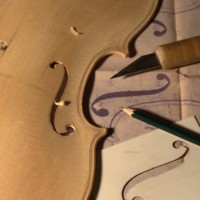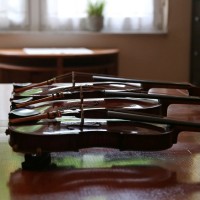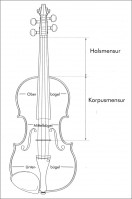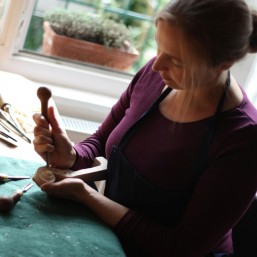
Viola Handbook |
Body Size and String Length
(Part 1)
This series of three articles on the topics «Viola Size», «Arching, Wood and Thickness» and «Fitting up» will expand your background knowledge of the viola. Let’s start with the violist’s most important selection criteria:
The Right Size
«You really need a smaller instrument!» With these words, my teacher encouraged me, 30 years ago, to finally buy my own instrument. The most important criteria: The size must be right: «39cm would be ideal for you, and would save you the pains with double stops!» When trying violas, I quickly noticed: It can’t be the body size alone, for some violas felt great, although they were too big. Back in time, I didn’t research this phenomenon any further: I was in love with the idea that the viola sound emerges from a mystery, that certain violas are just miraculously easy to play. This opinion is still very common nowadays. If you are inspired by the mysterious and miraculous, stop reading here. Otherwise, take a measuring tape and read on.
The Resonating String Length
Contrary to popular belief, whether a viola feels right does not depend on the body length, but on the length of the swinging string: That’s the distance from bridge to nut. While most violists know the body length of their instrument, almost none know about the swinging string length, also called stoplength. Even less known: This size varies regardless of the body size! There exist large violas with short string length and vice versa. Below is some violin maker theory for calculating the stoplength:
-
To start out, the position of the f-holes is chosen, which’s nicks determine the position of the bridge. Contrary to the violin and cello, there is no standard ratio for the viola!
-
The distance between f-hole nick (= bridge position) and the edge is the so called “bodystop”.
-
After the bodystop the neck length (=neckstop) is determind: It is two thirds of the bodystop.
-
Bodystop and neckstop plus a few millimeters, depending on the neck slant, determin the stoplenth (=swinging string lenth).
The determining factor for the stoplenth is thus the position of the f-holes. Because the violin maker isn’t tied to a specific ratio, the positioning is down to sonic, optical and technical preferences. That’s why there are many models on the viola market: I’ve come across string lengths between 34cm and 40cm. For comparison: The difference between the stoplenth of a 1/2 and 4/4 violin is 4cm! As already mentioned, the string length is not tied to the body size, as I would like to point out with an example of my two favorite violas.
A Very Exquisite Model: G.P. Maggini's Viola
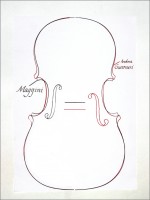 The drowing shows the shape of a viola by Andrea Guarneri (red line) and G.P. Maggini (black line). The body of both violas measures 41,6cm, and their width is almost identical. The only difference is in the waist: Maggini’s is clearly shorter, almost at the size of a violin.
The drowing shows the shape of a viola by Andrea Guarneri (red line) and G.P. Maggini (black line). The body of both violas measures 41,6cm, and their width is almost identical. The only difference is in the waist: Maggini’s is clearly shorter, almost at the size of a violin.
-
That’s why Maggini’s bridge needs to stay further up, the bodystop is very short with 20,5cm. The stoplenth is thus only 34,5cm long – a length we would more likely expect with a 3/4 viola.
-
Andrea Guarneri’s bodystop measures 22,2cm. This leads to a stoplenth of 37,5cm – a length in the upper midfield, as expected with this body size.
This is an extreme example, and practically speaking, extending the stoplenth for about 1cm, has proven to make the Maggini model more conform with today’s viola tone demands. Which leads us to our next topic:
The Effect of the String Length on the Viola Sound and Playability
Some more theory: The pitch of a string can be changed in two ways:
-
By changing the string length. If we put a finger on the string, the stringlenth becomes shorter, and the pitch is raised.
-
By changing the string tension: This procedure too, used for tuning, is known to any player. More string tension raises the pitch.
Looking at the violas stoplenth, we conclude: With a short stop, the string requires less tension. Less tension means that the string responds easier, the tone sounds darker and softer – characteristics that are especially appreciated by amateur violists. Professional violists on the other hand need more string resistance to shape their sound, and therefore mostly prefer instruments with higher string tension. Sonically speaking, the higher string tension makes the sound more brilliant and powerful. My experience, looking back on over 20 years as a professional:
-
At the string length of about 35,5cm, the viola starts sounding like a viola.
-
Professionals generally require a string length of 36cm, or better still, 36,5cm.
-
The sonority increases up to a length of about 37,5cm.
Of course, there exist great violas with even longer stoplenth, however, starting at 38cm string length, more and more problems come up. The sonority will be accompanied by a certain harshness, strings and also the viola itself take harm from higher string tension. There are further reasons for carefully evaluating, whether a viola with long stoplenth should be bought: Performing on such an instrument requires very long fingers, and resale can be difficult.
The body Size
Even though the body length is not the most important criteria when choosing a new viola, we shouldn’t ignore it entirely. The body itself is worth a closer look, too: Many violists will mainly look at the body length – however, for the sonority the body width is just as important! I am not aware on any scientific research on the connection between body size and beauty of sound on a viola, so I can only share my experience:
-
Upper bout and waist should be as wide as possible. However, not too wide, in order to ensure great playability. 19cm to 19,5cm for the upper bout and 13,5 – 14cm for the waist are proven values. A measure tape is used over the arching: With a high arching, the values may be slightly higher too.
-
Regarding the body length, I’ve made the following, interesting experience: Up to a body length of 42cm, the sonority increases, however, larger violas often won’t sound any louder. Often, but not always, these large violas have a hollow sidetone.
-
As a rule of thumb: half a cm more or less in width shapes the sonority more than half a cm in body length.
To conclude, a word of wording: The measures should never be seen isolated, following the slogan, “Only a viola with a 19cm wide upper bout is a good viola”. Measurements are, of course, only one factor, wood, arching and sound setting have a big influence on the sound too. Furthermore, the tastes for viola sounds differ just as much as with food, and by far not every violist is looking for tone volume. However, if you’re wondering why your 42cm viola doesn’t really sound loud, you might find part of your answer measuring it.
What experiences have you made with size and viola sound? Do your findings meet our observations, or did you gain completely different insights?
Here it goes to part 2: The Perfect Fit of a Viola
This blog article was written by Barbara Gschaider. She is a violin maker and runs a workshop in Bonn together with her husband. The main focus of her work is the viola. She also works as an author on the subject of violin making.
www.atelier-gschaider.de
Photos: Barbara Gschaider

Film music for string trio by Daniel Hauptmann

(1841-1904)
Romantische Stücke for Viola and Piano

Sonata for viola and piano, edited by Timon Altweg
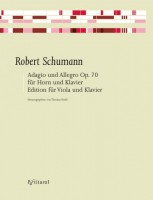
Adagio and Allegro, op. 70, for viola and piano, edited by Thomas Riebl

Building a viola in only 4 days
In November 2018 the International Viola Congress (IVC) took place in Rotterdam, Holland. During these four days four string instrument makers built a viola together. We were there and reported live.
» to the blog post

Georg Philipp Telemann was one of the most important composers of the Baroque period. He contributed innovative impulses to the development of music and significantly changed the musical world of the early 18th century.
» to the blog post
Hermann Ritter and his viola alta
Hermann Ritter, now generally quite forgotten, was actually one of the most respected and influential personalities in the history of the viola. Lionel Tertis is considered the first viola soloist. But that's not true...
» to the blog post
|
Viola news letter |
 Do you don't want to miss any news regarding viola anymore? Our monthly viola news letter will keep you informed.
Do you don't want to miss any news regarding viola anymore? Our monthly viola news letter will keep you informed.» Subscribe to our viola letter for free
|
|
 Visit and like us on Facebook.
Visit and like us on Facebook.» Music4Viola on Facebook

